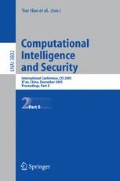Abstract
This paper considers a real-time risk assessment method for information systems and networks based on observations from networks sensors such as intrusion detection systems. The system risk is dynamically evaluated using hidden Markov models, providing a mechanism for handling data from sensors with different trustworthiness in terms of false positives and negatives. The method provides a higher level of abstraction for monitoring network security, suitable for risk management and intrusion response applications.
Access this chapter
Tax calculation will be finalised at checkout
Purchases are for personal use only
Preview
Unable to display preview. Download preview PDF.
References
Standards Australia and Standards New Zealand: AS/NZS 4360: 2004 risk management (2004)
Gehani, A., Kedem, G.: Rheostat: Real-time risk management. In: Jonsson, E., Valdes, A., Almgren, M. (eds.) RAID 2004. LNCS, vol. 3224, pp. 296–314. Springer, Heidelberg (2004)
Staniford-Chen, S., Cheung, S., Crawford, R., Dilger, M., Frank, J., Hoagland, J., Levitt, K., Wee, C., Yip, R., Zerkle, D.: GrIDS – A graph-based intrusion detection system for large networks. In: Proceedings of the 19th National Information Systems Security Conference (1996)
Snapp, S.R., Brentano, J., Dias, G.V., Goan, T.L., Heberlein, L.T., lin Ho, C., Levitt, K.N., Mukherjee, B., Smaha, S.E., Grance, T., Teal, D.M., Mansur, D.: DIDS (distributed intrusion detection system) - motivation, architecture, and an early prototype. In: Proceedings of the 14th National Computer Security Conference, Washington, DC, pp. 167–176 (1991)
Balasubramaniyan, J.S., Garcia-Fernandez, J.O., Isacoff, D., Spafford, E., Zamboni, D.: An architecture for intrusion detection using autonomous agents. In: Proceedings of the 14th Annual Computer Security Applications Conference, p. 13. IEEE Computer Society Press, Los Alamitos (1998)
Helmer, G., Wong, J.S.K., Honavar, V.G., Miller, L., Wang, Y.: Lightweight agents for intrusion detection. J. Syst. Softw. 67, 109–122 (2003)
Debar, H., Curry, D., Feinstein, B.: Intrusion detection message exchange format (IDMEF) – Internet-Draft (2005)
Ourston, D., Matzner, S., Stump, W., Hopkins, B.: Applications of hidden markov models to detecting multi-stage network attacks. In: Proceedings of the 36th Hawaii International Conference on System Sciences, HICSS (2003)
Warrender, C., Forrest, S., Pearlmutter, B.: Detecting intrusions using system calls: Alternative data models. In: Proceedings of the 1999 IEEE Symposium on Security and Privacy (1999)
Gong, F., Goseva-Popstojanova, K., Wang, F., Wang, R., Vaidyanathan, K., Trivedi, K., Muthusamy, B.: Characterizing intrusion tolerant systems using a state transition model. In: DARPA Information Survivability Conference and Exposition (DISCEX II), vol. 2 (2001)
Singh, S., Cukier, M., Sanders, W.: Probabilistic validation of an intrusion-tolerant replication system. In: de Bakker, J.W., de Roever, W.-P., Rozenberg, G. (eds.) International Conference on Dependable Systems and Networks (DSN 2003) (2003)
Rabiner, L.R.: A tutorial on hidden markov models and selected applications in speech recognition. Readings in speech recognition, 267–296 (1990)
Carver Jr., C.A., Hill, J.M., Surdu, J.R., Pooch, U.W.: A methodology for using intelligent agents to provide automated intrusion response. In: Proceedings of the IEEE Workshop on Information Assurance and Security (2000)
Porras, P.A., Neumann, P.G.: EMERALD: Event monitoring enabling responses to anomalous live disturbances. In: Proc. 20th NIST-NCSC National Information Systems Security Conference, pp. 353–365 (1997)
Author information
Authors and Affiliations
Editor information
Editors and Affiliations
Rights and permissions
Copyright information
© 2005 Springer-Verlag Berlin Heidelberg
About this paper
Cite this paper
Årnes, A., Sallhammar, K., Haslum, K., Brekne, T., Moe, M.E.G., Knapskog, S.J. (2005). Real-Time Risk Assessment with Network Sensors and Intrusion Detection Systems. In: Hao, Y., et al. Computational Intelligence and Security. CIS 2005. Lecture Notes in Computer Science(), vol 3802. Springer, Berlin, Heidelberg. https://doi.org/10.1007/11596981_57
Download citation
DOI: https://doi.org/10.1007/11596981_57
Publisher Name: Springer, Berlin, Heidelberg
Print ISBN: 978-3-540-30819-5
Online ISBN: 978-3-540-31598-8
eBook Packages: Computer ScienceComputer Science (R0)

